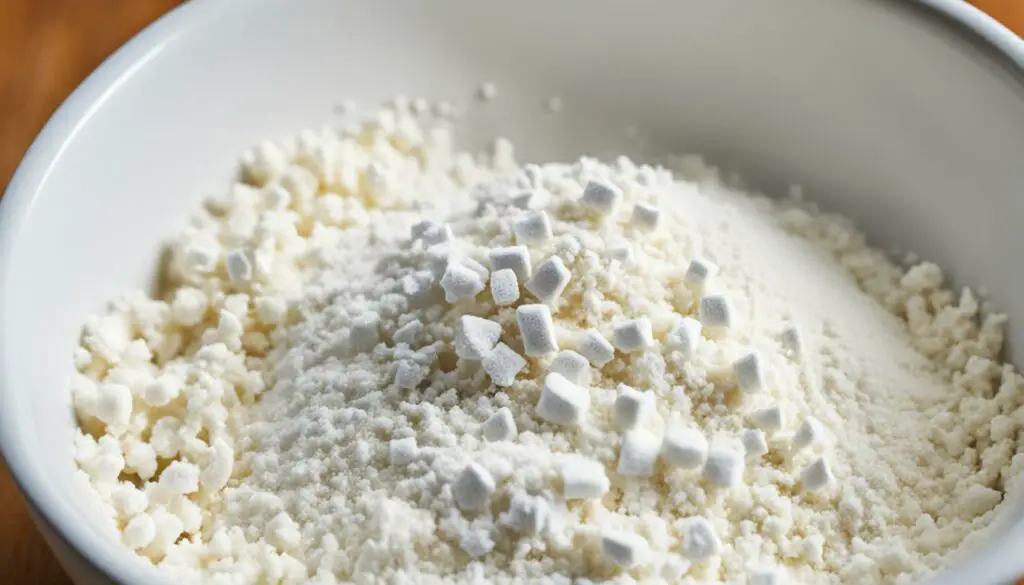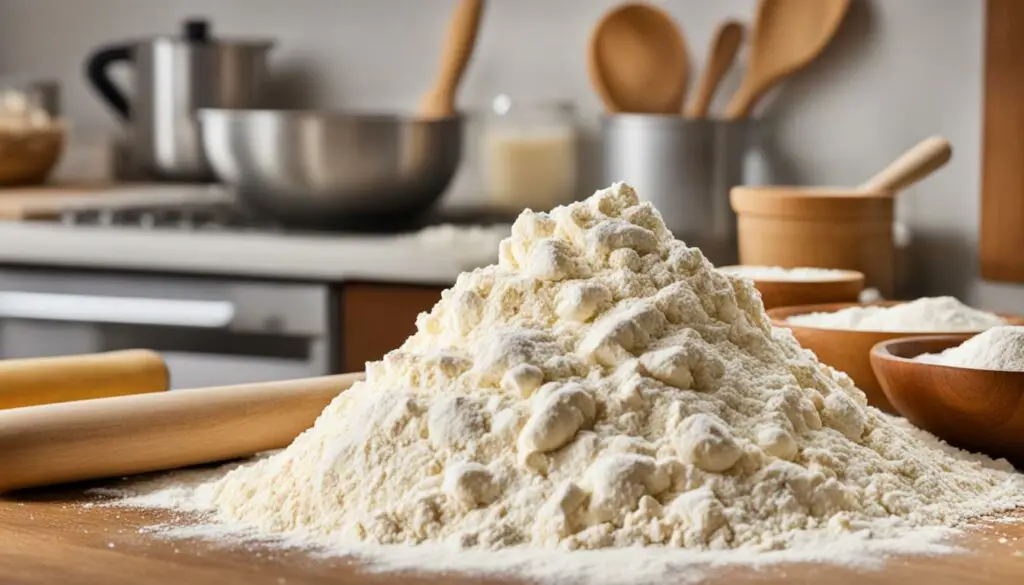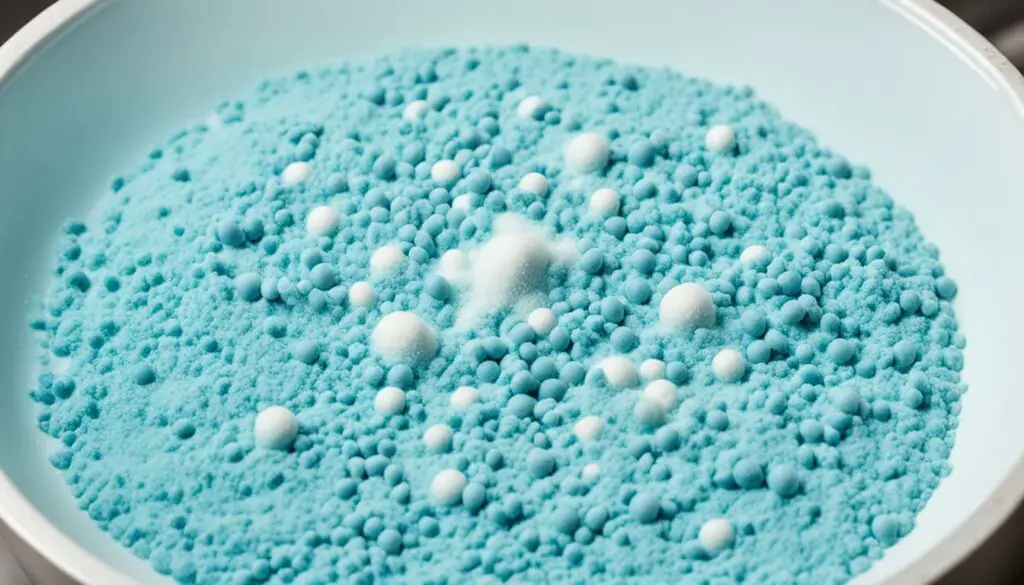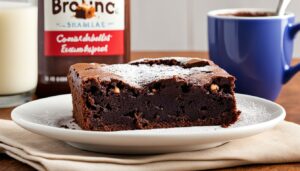Originally posted on March 26, 2024 @ 8:10 pm
Have you ever wondered if you can leave out baking powder in your recipes? Maybe you’ve run out of this essential ingredient and you’re wondering if you can substitute it with something else. But what would happen if you skip the baking powder altogether? Would your baked goods turn out as light and fluffy as you’d like them to be? Let’s uncover the truth behind skipping baking powder and explore the alternatives that can help you achieve the same mouthwatering results.
Contents
- 1 The Importance of Baking Powder in Baking
- 2 Can You Skip Baking Powder in Recipes?
- 3 Baking Powder Substitutes
- 4 The Risks of Leaving Out Baking Powder
- 5 Tips for Using and Storing Baking Powder
- 6 Experimenting with Baking Powder-Free Recipes
- 7 Understanding the Science of Baking Powder
- 8 Conclusion
- 9 FAQ
- 9.1 Can I leave baking powder out of a recipe?
- 9.2 What are some baking powder substitutes?
- 9.3 What happens if you leave out baking powder?
- 9.4 How should I store baking powder?
- 9.5 Are there any baking powder-free recipes?
- 9.6 How does baking powder work?
- 9.7 Should I use baking powder past its expiration date?
- 9.8 Is it possible to achieve the same results without baking powder?
- 10 Source Links
Key Takeaways:
- Skipping baking powder in recipes can lead to dense and flat results.
- Baking powder is an important leavening agent that helps baked goods rise and achieve a light texture.
- If you need to substitute baking powder, options like cream of tartar and baking soda can be used.
- Experimenting with baking powder-free recipes and alternative leavening methods can provide new culinary possibilities.
- Proper storage and fresh baking powder are essential for optimal baking results.
The Importance of Baking Powder in Baking
Baking powder plays a crucial role in baking by acting as a leavening agent. It helps dough and batter rise by releasing carbon dioxide gas when it reacts with moisture and heat. This gas expands and creates air pockets, resulting in a light and airy texture in the final baked goods. Baking powder is specifically designed to provide a controlled release of carbon dioxide, ensuring that the dough or batter rises evenly. It also helps in tenderizing the baked goods by breaking down proteins. Without baking powder, the lack of leavening may result in dense and heavy baked goods, lacking the desired fluffiness.
Why is Baking Powder Important?
Baking powder is essential in baking because it contributes to the overall texture and structure of the finished product. It helps create those light, fluffy, and tender cakes, muffins, and biscuits that we all love. Without baking powder, your baked goods may turn out flat, dense, and lacking in volume.
Leavening agents, like baking powder, play a vital role in the chemical reactions that occur during baking. They release carbon dioxide gas, which gets trapped in the dough or batter, causing it to rise. This process creates air pockets and gives baked goods their characteristic lightness and softness.
The Role of Baking Powder in Baking
Baking powder is a mixture of an acid (such as cream of tartar) and an alkaline (usually baking soda). When combined with moisture and heat, the acid and alkaline components react, producing carbon dioxide gas. This gas causes the dough or batter to rise, resulting in a fluffy and well-structured final product.
Baking powder provides a controlled release of carbon dioxide, allowing the dough or batter to rise evenly. Without it, the release of gas would be unpredictable, leading to uneven textures and inconsistent results.
The Importance of Leavening Agents in Baking
Leavening agents are crucial in baking because they give the desired rise and texture to baked goods. They create the light, airy, and tender crumb that we associate with well-made cakes, breads, and pastries.
Aside from baking powder, other leavening agents used in baking include yeast, baking soda, and sourdough starter. Each of these agents has its own unique properties and reacts differently to different ingredients and temperatures. The choice of leavening agent depends on the specific recipe and the desired outcome.
| Leavening Agent | Usage |
|---|---|
| Baking Powder | Used in recipes that require quick and even rising, especially in cakes, muffins, and biscuits. |
| Yeast | Used in bread and other yeast-based doughs to create a slow and gradual rise, resulting in a flavorful and chewy texture. |
| Baking Soda | Used in recipes that have acidic ingredients, such as buttermilk or lemon juice, which react with the baking soda to produce carbon dioxide gas. |
| Sourdough Starter | Used in sourdough bread recipes to provide both leavening and flavor. The natural yeast in the starter ferments and produces carbon dioxide gas. |
Can You Skip Baking Powder in Recipes?
While it’s technically possible to skip using baking powder in a recipe, it’s not recommended unless you have a suitable alternative. Baking powder provides the necessary leavening for your baked goods, and omitting it may lead to flat and dense results. However, in certain cases where a minimal rise is desired, such as in certain cookies or pie crusts, you may be able to omit the baking powder without a significant impact on the final texture. It’s important to note that this may vary depending on the specific recipe and desired outcome.
Baking Powder Substitutes

If you find yourself in a situation where you need a baking powder substitute, there are several alternatives you can try. Experimenting with these substitutes can help you achieve satisfactory results in your recipes:
- Cream of tartar and baking soda: A commonly recommended substitute, this mixture can be used in a ratio of half a teaspoon of cream of tartar and a quarter teaspoon of baking soda for every teaspoon of baking powder. This combination provides the necessary acidity and leavening power.
- Self-rising flour: Another option is to use self-rising flour, which already contains baking powder. Simply replace the regular flour in your recipe with self-rising flour, adjusting other leavening agents accordingly. This option works well for recipes that call for a significant amount of flour.
- Lemon juice: Adding a small amount of lemon juice can provide the necessary acidity to help your baked goods rise. Use approximately half a teaspoon of lemon juice for every teaspoon of baking powder. Be mindful of the citrusy flavor it may impart to your recipe.
- Vinegar: Similar to lemon juice, vinegar can also provide the acidity needed for leavening. Use approximately half a teaspoon of vinegar for every teaspoon of baking powder. The flavor of vinegar may vary depending on the type used.
- Yogurt: In certain recipes, substituting yogurt for baking powder can yield satisfactory results. Use half a cup of yogurt for every teaspoon of baking powder. Adjust the liquid content in the recipe accordingly.
- Club soda: When you require the carbonation provided by baking powder, club soda can be used as an alternative. Replace the liquid in your recipe with an equal amount of club soda.
It’s important to note that these substitutes may affect the taste and texture of your baked goods, so experimentation and recipe adjustments may be necessary. Select the substitute that best suits your recipe and desired outcome. Remember to consider the specific flavors and characteristics each substitute brings to the table.
Baking Powder Substitutes
| Substitute | Substitution Ratio | Characteristics |
|---|---|---|
| Cream of tartar and baking soda | 1/2 tsp cream of tartar + 1/4 tsp baking soda for 1 tsp baking powder | Provides acidity and leavening power |
| Self-rising flour | Replace regular flour with self-rising flour | Contains baking powder as an ingredient |
| Lemon juice | 1/2 tsp lemon juice for 1 tsp baking powder | Imparts a citrusy flavor |
| Vinegar | 1/2 tsp vinegar for 1 tsp baking powder | May have a distinct vinegar taste |
| Yogurt | 1/2 cup yogurt for 1 tsp baking powder | Impacts moisture and texture |
| Club soda | Replace liquid with an equal amount of club soda | Provides carbonation |
The Risks of Leaving Out Baking Powder
When you leave out baking powder from a recipe, the consequences can be significant. Without this essential leavening agent, your baked goods may suffer in terms of texture and appearance. Let’s take a closer look at what happens when you don’t use baking powder in your recipes.
The Consequences of Omitting Baking Powder
When you omit baking powder, your baked goods may turn out dense, flat, and lacking the desired fluffy texture. Baking powder plays a crucial role in providing the necessary rise and lightness to your treats. It achieves this by releasing carbon dioxide gas when it reacts with moisture and heat.
Without this carbon dioxide release, the dough or batter will not rise properly, leading to a less appealing appearance and a less enjoyable eating experience.
“Without baking powder, your baked goods may turn out dense and flat.”
Additionally, the absence of baking powder may affect the overall structure and tenderness of the baked goods. The chemical reaction caused by baking powder helps tenderize the final product by breaking down proteins. Without this reaction, the texture may become less desirable.
A Visual Comparison
| With Baking Powder | Without Baking Powder |
|---|---|
Problems with Skipping Baking Powder
Skipping baking powder can lead to multiple problems in your baked goods:
- Flat and dense texture: Without the leavening action of baking powder, your treats may lack the desired rise and end up with a flat and dense texture.
- Lackluster appearance: The absence of baking powder can result in baked goods that look uninspiring and less visually appealing.
- Toughness: Baking powder helps tenderize the final product. Without it, the baked goods may become tougher and less enjoyable to eat.
“Skipping baking powder can lead to flat and dense baked goods with a lackluster appearance.”
While it’s possible to overcome these challenges with certain recipes and alternative ingredients, it’s generally best to follow the recipe’s instructions and include the recommended amount of baking powder.
Tips for Using and Storing Baking Powder
Properly storing and using baking powder is essential to ensure the best results in your baking endeavors. Here are some tips to help you preserve the effectiveness of your baking powder and achieve light and fluffy baked goods:
1. Store in a Cool and Dry Place
It’s important to store baking powder in a cool and dry place, away from moisture and direct sunlight. Exposure to humidity can reduce its potency and affect its leavening abilities. Consider using an airtight container to protect it from moisture and other contaminants.
2. Check the Expiration Date
Baking powder has a shelf life, and using it past its expiration date may result in less effective leavening. Check the packaging for the expiration date and discard any baking powder that has exceeded it. Using fresh baking powder ensures optimal results in your baking.
3. Use Within 6 to 12 Months
Once opened, it’s advisable to use baking powder within 6 to 12 months for maximum leavening power. Over time, its effectiveness may gradually diminish, leading to less impressive results in your baked goods.
4. Conduct a Freshness Test
If you’re unsure about the freshness of your baking powder, you can perform a quick test to check its potency. Mix a small amount of baking powder with warm water. If it bubbles vigorously, it’s still fresh and suitable for use. However, if the reaction is weak or nonexistent, it’s time to replace it with a fresh batch.
5. Avoid Contamination
When using baking powder, ensure that the measuring utensils and any other ingredients that come into contact with it are clean and dry. Contamination can affect the quality of your baking powder and potentially hinder its leavening capabilities.
6. Measure Accurately
For optimal results, it’s crucial to measure baking powder accurately according to the recipe’s instructions. Using too little or too much can impact the final texture and taste of your baked goods. Consider using a digital kitchen scale to ensure precise measurements.
By following these tips, you’ll be able to store and use baking powder effectively, maintaining its leavening power and achieving delicious and airy baked goods.
Experimenting with Baking Powder-Free Recipes

While it may be challenging to achieve the same level of rise and fluffiness without baking powder, there are recipes that can be enjoyed without it. Some traditional recipes, like certain shortbreads and pie crusts, don’t rely on leavening agents for their desired texture. These recipes often focus on the buttery flavor and crumbly texture instead. You can also explore international recipes that use alternative leavening methods, such as yeast or beaten egg whites. Additionally, some alternative baking techniques, like steam baking or whipped egg whites, can help create a lighter texture without the need for baking powder. Experimenting with these recipes can open up new culinary possibilities and allow you to enjoy baked goods even without baking powder.
Traditional Baking Powder-Free Recipes
Traditional recipes that don’t rely on baking powder for leavening can be a delightful alternative. These recipes often have a rich heritage and unique flavors. Let’s take a look at a couple of examples:
1. Shortbread Cookies: Shortbread cookies are a classic treat that doesn’t require baking powder to achieve the desired texture. The combination of butter, sugar, and flour creates a crumbly and melt-in-your-mouth cookie. Experiment with different flavor variations like adding citrus zest or chopped nuts.
2. Pie Crust: Many pie crusts, like traditional butter pie crusts, achieve their flaky and tender texture without baking powder. The secret lies in the incorporation of cold butter into the flour, creating a flaky pastry shell perfect for both sweet and savory pies.
International Recipes with Alternative Leavening Methods
Exploring international recipes can introduce you to unique flavors and alternative leavening methods. Here are a few examples:
1. Pizza Dough: Traditional pizza dough recipes often use yeast as a leavening agent, resulting in a light and chewy crust. With the help of yeast, you can achieve a similar rise and texture as baking powder, allowing you to enjoy homemade pizza without relying on a leavening agent.
2. Soufflé: Soufflé is a classic French dish that utilizes beaten egg whites to create a light and airy texture. By gently folding beaten egg whites into your soufflé mixture, you can achieve a rise that rivals the effects of baking powder.
Alternative Baking Techniques
Aside from using alternative leavening methods, there are a few alternative baking techniques that can help create a lighter texture without the need for baking powder:
1. Steam Baking: Steam baking involves placing a dish of water in the oven while baking, creating steam that helps the baked goods rise. This technique is commonly used for bread and certain cakes to achieve a light and airy texture without relying on baking powder.
2. Whipped Egg Whites: Whipped egg whites can act as a natural leavening agent in some recipes. By beating the egg whites until stiff peaks form and gently folding them into the batter, you can create a light and fluffy texture without the need for baking powder.
Experimenting with these baking powder-free recipes and techniques can lead to delightful surprises in your baking adventures. Whether you’re exploring traditional classics or trying out international flavors, there’s a whole world of baking possibilities waiting for you, even without baking powder.
Understanding the Science of Baking Powder

Baking powder is a key ingredient in baking that works through a fascinating chemical reaction. By understanding how baking powder functions, you can appreciate its role in creating light and fluffy baked goods.
Baking powder consists of two main components: an alkaline ingredient, typically baking soda, and an acid component, such as cream of tartar. When these two elements come into contact with moisture and heat, they undergo a chemical reaction.
This chemical reaction releases carbon dioxide gas, which is essential for creating the desired rise in baked goods. The gas expands within the dough or batter, causing it to become light and airy. This process, called leavening, is what gives your cakes, muffins, and breads their appealing texture.
The acid in the baking powder serves an important purpose. It helps regulate the release of carbon dioxide, ensuring a controlled and even rise. This provides consistent results and prevents the baked goods from collapsing or becoming overly dense.
In summary, baking powder works by creating a chemical reaction that generates carbon dioxide gas, allowing dough and batter to rise. The acid component helps control the release of gas, resulting in light and fluffy baked goods.
“Understanding the science behind baking powder can help you make informed decisions when it comes to choosing substitutes and alternatives.”
The efficacy of baking powder relies on its ability to retain its leavening power. Over time, baking powder can lose potency. That’s why it’s important to store it properly and use it within its expiration date.
To store baking powder:
- Keep it in a cool and dry place, away from moisture and direct sunlight. This helps maintain its effectiveness.
- Ensure the container is tightly sealed to prevent exposure to air and moisture.
Even with proper storage, baking powder will eventually lose its potency and may need to be replaced. It’s always a good idea to check the expiration date on the packaging and discard any baking powder that has exceeded its shelf life.
The Science of Baking Powder – Explained in a Table:
| Chemical Reaction | Role of Baking Powder |
|---|---|
| The combination of an alkaline ingredient and an acid component reacts with moisture and heat. | Creates carbon dioxide gas to provide the necessary leavening for baked goods. |
| The acid component helps control the release of carbon dioxide, ensuring a controlled and even rise. | Promotes consistent results and prevents baked goods from collapsing or becoming too dense. |
Now that you understand the science behind baking powder, you can make informed decisions when it comes to selecting substitutes and alternatives. By appreciating its role in the baking process, you can experiment with confidence and achieve delicious results.
Conclusion
In conclusion, while it is possible to skip using baking powder in certain recipes and substitute it with alternative ingredients, it’s important to understand the impact it may have on the final results. Baking powder plays a crucial role in creating the desired rise, texture, and tenderness in baked goods. Omitting it entirely may lead to less desirable outcomes, such as dense and flat baked goods.
However, with careful experimentation and adjustments, you may be able to achieve satisfactory results without baking powder in certain cases. It’s essential to consider the specific recipe, desired outcome, and available alternatives when deciding whether to omit or substitute baking powder.
Remember, baking is both an art and a science, and finding the right balance between ingredients is key. So, whether you choose to use baking powder or explore other options, happy baking!
FAQ
Can I leave baking powder out of a recipe?
While it’s technically possible to skip using baking powder in a recipe, it’s not recommended unless you have a suitable alternative. Baking powder provides the necessary leavening for your baked goods, and omitting it may lead to flat and dense results.
What are some baking powder substitutes?
Some common baking powder substitutes include a mixture of cream of tartar and baking soda, self-rising flour, lemon juice, vinegar, yogurt, and club soda. These alternatives may affect the taste and texture of your baked goods, so experimentation and recipe adjustments may be necessary.
What happens if you leave out baking powder?
Without baking powder, your baked goods may turn out dense and flat. The lack of leavening may result in a less appealing appearance and a less enjoyable eating experience. Baking powder also contributes to the structure and tenderness of the baked goods.
How should I store baking powder?
To ensure the effectiveness of your baking powder, store it in a cool and dry place, away from moisture and direct sunlight. Once opened, it’s best to use it within 6 to 12 months.
Are there any baking powder-free recipes?
Yes, there are recipes that can be enjoyed without baking powder. Some traditional recipes, like certain shortbreads and pie crusts, don’t rely on leavening agents for their desired texture. You can also explore international recipes that use alternative leavening methods, such as yeast or beaten egg whites.
How does baking powder work?
Baking powder works through a chemical reaction that occurs when it comes into contact with moisture and heat. It consists of an alkaline component (usually baking soda) and an acid component (such as cream of tartar). When these two components react with moisture, they release carbon dioxide gas, which causes the dough or batter to rise.
Should I use baking powder past its expiration date?
It’s recommended to use baking powder within its expiration date for the best results. Baking powder can lose its potency over time, leading to less effective leavening.
Is it possible to achieve the same results without baking powder?
While it may be challenging to achieve the same level of rise and fluffiness without baking powder, there are recipes that can be enjoyed without it. Some alternative baking techniques, like steam baking or whipped egg whites, can help create a lighter texture without the need for baking powder.








